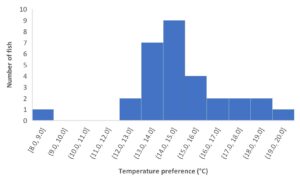Improving lumpfish welfare

Researchers at the University of Swansea have developed a new tool to help in the care of lumpfish
Swansea University will be delivering an exciting workshop at the Aquaculture UK trade show, entitled “Tools for improving the welfare of lumpfish”. The workshop will take place on 5 May 2022 from 12:00 to 13:00 and is free to all attendees.
The workshop will consist of two main topics followed by a discussion panel:
1) facilitated hands-on test session of the Lumpfish Welfare Watcher – a web-based and desktop application designed to help fish farmers assess and improve the welfare of Lumpfish; and
2) using AI to improve lumpfish welfare.
During the workshop, attendees will get a free lumpfish welfare chart and learn how to use it in combination with the following lumpfish welfare tools: the lumpfish BMI calculator for the detection of underweight fish and the Rapid Welfare Assessment Tool to calculate the overall welfare of lumpfish.
On 4 May, CSAR will be at SAIC’s stall from 15:00 to 15:30, showcasing its cleaner fish research and how CSAR is training the next generation of aquaculture professionals.
“We encourage everyone interested in fish welfare – farmers, researchers, students, vets, and welfare interest groups to attend this exciting workshop”, said Dr Sara Barrento, Swansea University, speaker and organiser of the workshop.
This is the second joint event in a series organised and supported by the projects Access2Sea, funded by the Interreg Atlantic Area Programme through the European Regional Development Fund and the Seafood Innovation Fund (SIF). It is led by the Centre for Sustainable Aquatic Research (CSAR), Swansea University
The first event took place during Lochaber Ideas Week – Aquaculture Day in Fort William, Scotland on 17 November 2021.
For more information:
Lochaber Ideas Week link: www.sustainableaquaculture.com/news-events/lochaber-ideas-week-aquaculture-day/
SIF: bsciweb.swan.ac.uk/lumpfish/docs/LUMPFISH_WELFARE_WATCHER_WEB_INTERFACE_GUIDE.pdf
Acces2Sea: access2sea.eu/event/application-of-sensors-in-precision-aquaculture/
To learn more and keep up to date on coming events follow us on Twitter @CSAR_ACE twitter.com/csar_ace
Each to their own
A study has revealed unexpected sea bass individual temperature preferences.
Shuttle box experiments with sea bass revealed that there are large individual differences in temperature preference, varying from a maximum of 19.6 °C to a minimum of 8.0°C. Mean temperature preference was 14.9 ± 2.2 °C (± SD), which was close to the temperature of the environment where the fish were originally collected (16 °C) and the temperature of the holding tanks (15 °C).

Graph showing temperature preference data for the 30 sea bass tested in the shuttle box
The Centre for Sustainable Aquatic Research (CSAR) has recently acquired a shuttle box – a two-compartment box, in which the temperature increases in one compartment and decreases in the other. Both compartments start with the same temperature and the fish can swim freely between the two and choose to stay on the side that is more pleasant.

Shuttle box showing the two preference
zones (of low and high temperature); the sea bass being tested is highlighted in red
(Chloe Woodland)
In this preliminary experiment with 30 sea bass, some fish moved frequently and thereby only allowed slow changes in core temperature, while others chose to move less frequently in the shuttle box, thereby exposing themselves to relatively rapid changes in core temperature.
This is somewhat surprising given the fish are from the same age class, were collected at the same location, and have been held under standardised conditions. This research is funded by the STREAM project, under The Ireland Wales 2014-2020 European Territorial Co-operation (ETC) programme, and we will be investigating the underlying mechanisms that determine individual differences in temperature preference, including behavioural (boldness), physiological (metabolism) and morphological (size, body shape) traits.
For more information on the STREAM project, see www.marinestream.eu/
Contact for both of the above topics: Dr Sara Barrento, S.I.barrento@swansea.uk (email),
+44 (0)788 412 1703 (tel).


